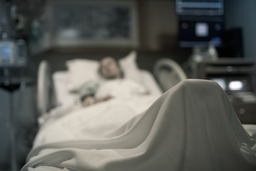A Non-Contact System and Method for Patient Motion Monitoring
TECHNOLOGY NUMBER: 2019-074

OVERVIEW
A real-time, contactless monitoring system that detects movement in bedbound patients- Sensors measure mattress deflections that reveal absence of movement or bed egress
- Alerts caregivers to minimize pressure ulcer formation, falls, or undetected seizures
BACKGROUND
The number of Americans over the age of 65 years is projected to increase to 25% of the population by 2060, with a concomitant expansion in the need for healthcare and assisted living situations. The existing number of patients in this age group has already created a need to mitigate risks caused by limited mobility such as bed sores and falls. For patients who spend most or all their time in bed, there is a growing need for smart monitoring systems to aid healthcare providers in detecting clinically important issues. Pressure sores result when patients do not routinely readjust themselves in bed or are completely immobile and are not repositioned by caregivers at appropriate intervals. Also, there is a fall risk for bed-ridden patients who get out of bed without assistance.
While many solutions have been proposed to provide real time monitoring of patient movements in bed, currently available sensors suffer from several limitations. Contacting sensors can often be uncomfortable, are not made from breathable material, and may break down quickly. On the other hand, most non-contacting sensors require bulky equipment or extensive modifications to mattress construction, alterations that are not readily adaptable to current healthcare equipment. A need exists for a new method to evaluate patient movements while they lay in bed to diminish the chances for significant sequelae.
INNOVATION
Researchers at the University of Michigan have developed a real-time monitoring system that does not require physical contact with the skin to detect clinically important patient motions while they lie in bed. These sensors can identify lack of motion for prolonged periods, unexpected movement out of bed, and repetitive physical movement which may accompany seizure activity. The sensors are mounted on the sides of the mattress to measure localized acceleration with the intent of alerting healthcare providers of clinically relevant events. Several sensors are placed along the vertical edges of the mattress to detect motion from bulging on the sides of a mattress that occurs when a patient moves in bed. Vertical movements on the bed create perpendicular deflections of the mattress which are detected by the device, as is defined by the Poisson Effect. The sensors directly measure acceleration at key locations along the mattress and use this information to signal clinically important events. The goal is to assist in helping to prevent decubitus ulcers in critically ill patients, falls during bed egress, and undetected seizures in epilepsy patients by providing early warning to care providers.